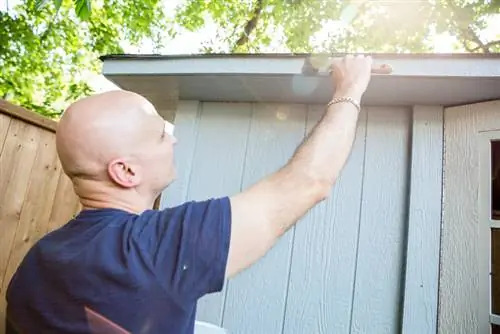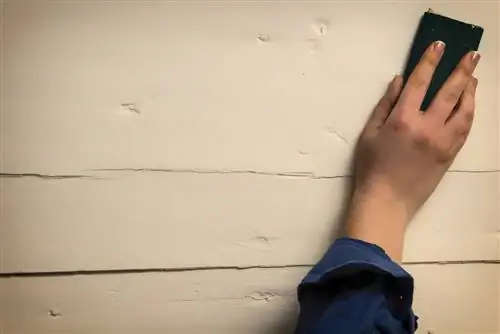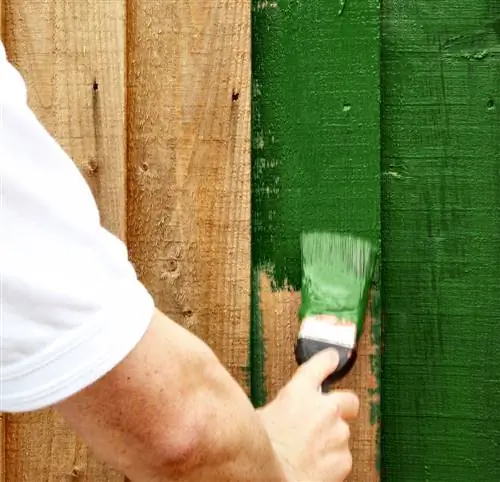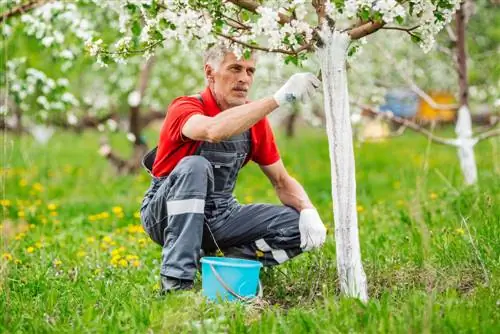- Author admin [email protected].
- Public 2023-12-16 16:46.
- Last modified 2025-01-23 11:22.
Wooden garden houses create an atmosphere of well-being. To ensure that the house stands for a long time and is not damaged by wind and weather, it needs to be painted correctly. The possibilities are wide-ranging. Their execution requires a certain basic knowledge.
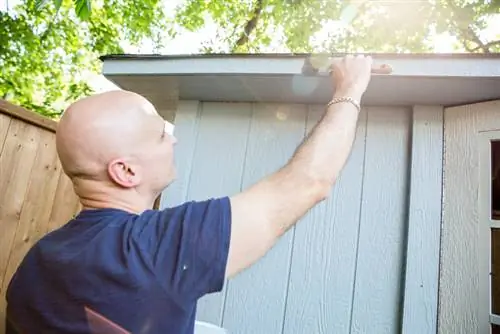
How often should you paint a garden shed?
In order to optimally protect and preserve a garden house, it should be painted regularly. Depending on the paint used - oil, glaze or paint - the necessary intervals vary from 2-4 years for oil and glazes to 10-15 years for varnishes and paints.
Protecting the wood
Wood is a raw material that is exposed to the weather and is constantly changing. It is therefore important that you paint your garden house correctly before building it. Regular repainting is necessary because the paint is not permanent.
Why a coat of paint is important:
- Moisture: damp wood swells and forms cracks when it dries
- Sunlight exposure: Wood yellows and turns dark
- Pests: Blue stain fungi, sponges and insects damage untreated or damp wood
Oil, glaze or paint?

Basic protection made from oil needs to be renewed more often than a coat of paint
Before painting, you should think about what the garden house will look like later. You can retain the natural character and only provide the wood with a transparent protective layer. The paint should be renewed every ten to 15 years. Basic protection from glazes or oils must be refreshed every two to four years.
| Suitability | Features | Special feature | |
|---|---|---|---|
| Oil | Hardwoods | transparent | environmentally friendly and water-repellent layer |
| Lasur | Softwoods | transparent or slightly pigmented | preserves natural wood grain |
| color | Soft and hardwoods | covering | long-lasting UV protection |
Lasures and paints
Gray or classic white are popular colors for a simple and modern garden house. Swedish red or blue are in vogue. Accents on door frames or roof gables in white go well with such paints. Light colors such as pine are popular for glazes.
Excursus
The Swedish red and its history
Sweden Red is an outdoor emulsion paint that is mainly produced in Sweden. Its history goes back to the 16th century. At that time, copper mining in Falun produced a reddish-brown pigment that was mixed into paints. Wooden houses painted with the paint were reminiscent of the brick buildings of we althy Central Europeans. Over the centuries, red has become the national color. It went down in history as Falunröd and is still typical of wooden buildings in rural areas today.
This should be taken into account when using glazes
Pigmented glazes ensure protection against UV radiation. The darker the pigmentation of the paint, the better the wood is protected from radiation. Colorless glazes do not provide sun protection. The garden house should be painted two to three times. It is possible to paint over old paint if it is a thick-film glaze. Thin-layer glazes must be completely sanded off.
Thick and thin layer glazes
A thick-film glaze is an open-pored and translucent coating with paint-like properties. The protective layer is water-repellent and still permeable to diffusion. This makes such glazes ideal for outdoor use. Thick-film glazes can also be mixed with a UV blocker.
Thin-film glazes are less suitable as an exterior paint for garden houses. They are also open-pored and translucent, but do not form a closed coating film. The wood can continue to absorb moisture and swells. Follow-up coats are necessary regularly as the thin-layer glaze washes out quickly on the outside.
What you should pay attention to when painting colors
If you want to paint the wood in color, you should impregnate it beforehand. For an optimal result, a layer of oil is first applied, which is then coated with a primer. It ensures that the paint adheres better to the wood and does not peel off. It also prevents yellowish discoloration, which often occurs with white paint due to escaping wood ingredients.
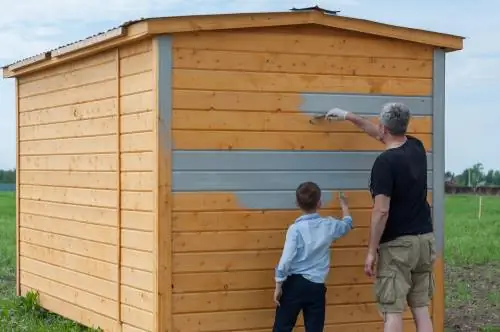
Various colors can be used to paint the garden house
Oil, solvent or water based paints
The category of solvent-based paints includes products that contain oils or acrylic resin. Therefore, the terms oil-based and solvent-based are used interchangeably. Such paints have a longer drying time, which makes them more suitable for large areas. Thanks to their high solids content, these colors ensure high opacity and are extremely economical. They cover color differences in the wood and preserve the natural wood structure. When stored dry, oil-based paints have a shelf life of approximately five years.
Properties of oil-based paints:
- very hard surface that becomes brittle over time
- strong smell when drying
- good adhesion properties on the surface
- harmful to the environment and hazardous to he alth
Water-based paints are less opaque, dry faster and are more environmentally friendly. During painting, the wood fibers stand up, creating a rough surface. Therefore, the wood should be sanded before painting if a smooth result is desired. The colors are permeable to water vapor, which prevents bubbling and peeling of the paint. The colors are sensitive to frost and should be kept in the cellar during the winter. Their shelf life is limited to around 24 months. Water-based paints are usually referred to as emulsion paints.
Preparations before painting
When you build a new garden house, the steps of sanding and cleaning are no longer necessary. Untreated wood requires impregnation. With pre-treated wood, this step is also unnecessary and you can go straight to priming.
The wood is ideally protected when it is impregnated, primed and painted.
Sanding and cleaning
Weathered wood or old paint residues are sanded off with coarse sandpaper. If the wood has already been painted, you can roughen the paint layer with a wire brush. The flaking residue can be scraped off with a spatula and smoothed with fine sandpaper. The wood must dry before painting and be free of grease or dust particles. You can use turpentine (€17.00 on Amazon) or a turpentine substitute. Ballistol offers a he alth-safe alternative. It not only cleans, but also serves to preserve wood.
Impregnation
Impregnation is of great importance because it ensures sustainable wood protection. Cheap products are often of inferior quality and quickly wash out of the wood. All wooden parts should be impregnated before construction. This is the only way to completely cover wooden planks with a protective layer, which will later be pushed into each other using tongue and groove.
Floor and walls inside are usually not impregnated because they are not exposed to the weather. If you use the garden shed as a tool shed, you should also protect the interior. Additionally impregnate the underside of the wooden floor so that it is protected from rising moisture. If you want to apply glazes or top coats, the waterproofing layer should dry for at least 24 hours. For optimal results, apply several coats of oil.
Suitable impregnations:
- Outdoor area: natural linseed oil or treated hard oil
- Indoor use: beeswax or plant wax

Priming
This layer is the basis for the long durability of the subsequent glaze or paint coats. It ensures that paint or glaze adheres optimally to the waterproofing layer. Pigmented primers also protect the paint from discoloration. These must be coordinated with the following coat. Wood protection primers are available on a water or solvent basis.
Tip
Start impregnating immediately after purchasing a new garden shed if you cannot store the wood dry. This way you prevent it from absorbing moisture during storage.
Painting the garden house
Regardless of whether you want to paint a new garden shed or refresh an old garden shed, you should carry out the work at a minimum temperature of ten degrees Celsius. Warm and dry conditions favor the drying processes and the paints are easier to apply.
Renew paint
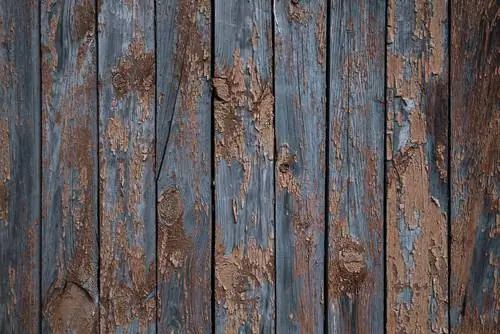
If you don't want to sand off peeling paint, you can use oil to protect the old wood
For surfaces that have already been weathered, it may be advisable to use an oil-based paint. This ensures a flat and even surface without having to sand the wood first. For reasons of better environmental compatibility and lower he alth risks, water-based paints are also the better choice for old wood. Even if the preparation is more labor-intensive, you benefit from a longer lifespan of the paint.
The perfect coat of paint:
- Processing the wooden facade with a steel brush
- Sand off paint residue thoroughly
- Impregnate wood with oil if necessary
- apply primer after a drying time of 24 hours
- let dry for another 24 hours
- paint in the desired color with a soft brush in the direction of the grain
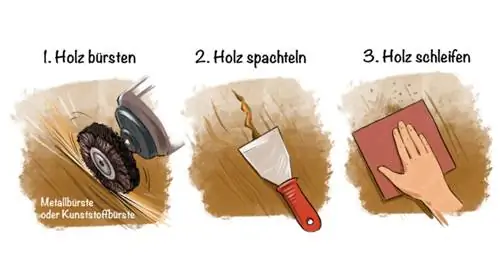
Tip
Exterior walls facing south or west should be given three coats of paint. This means they are better protected from the weather.
Frequently asked questions
How often do I have to paint a garden shed?
The interval depends on the respective coat of paint. Pure oil impregnations should be renewed every two to four years. This also applies to glazes. Coats of varnish or paint last much longer and require a refresh after about ten to 15 years.
How much does it cost if I want to have a garden shed painted?
Painting costs vary depending on the company. Factors such as hourly rate, square meter, travel distance and workload play a role. Some companies summarize all costs in the so-called painted square meter. To do this, the employee needs information about dimensions and whether the garden house should be repainted or refreshed.
Will the garden house be painted before or after construction?
That depends on whether the wood is pre-treated or natural. Pure wood should be impregnated before construction so that areas that will no longer be accessible later can be protected. Primers and paints can be applied after construction.
Can I paint the wood without sanding?
This is possible if you use oil-based paints. These leave a smooth surface, but are harmful to the environment and he alth. Therefore, you should use water-based products that are applied after sanding.

